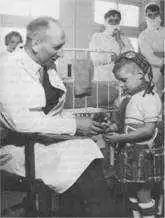
Celiac.com 09/06/2019 (Originally published 04/05/2010) - I have a mental calendar that outlines some of the major contributors to the celiac community. It is a limited one, as I can not list all of the many thousands of contributors to our community. But I think I am aware of some of the most prominent of these, beginning with the discovery of the efficacy of the gluten free diet.
In the 1930s, the most significant insight into celiac disease came from Dr. Willem Karel Dicke, a towering giant in the field of celiac research. His contribution of the gluten-free diet is the single most powerful contribution to the celiac community that has ever been made. Although others expressed insight into this condition, Dr. Dicke serves, in my mind, as the starting point for a modern understanding of celiac disease and gluten sensitivity. We cannot guess just how long it might have taken before some other pediatrician or gastroenterologist listened to the insightful comments of a concerned mother who had noticed that her child’s skin rash (possibly dermatitis herpetiformis) resolved when wheat was removed from the child’s diet. Please pause for a moment to think about this. Even seventy five years after Dr. Dicke’s discovery, would your physician, or your child’s pediatrician, investigate a nutritional theory you offered him or her? I think very highly of her, but I’m not sure that my physician would do so. The fact that Dr. Dicke listened that carefully to this concerned mother is the springboard that vaulted him to what I believe is the single greatest achievement in the history of celiac disease.
Celiac.com Sponsor (A12):
By the 1950s, after Dr. Dicke’s thesis was published, the Crosby capsule was developed by Dr. William H. Crosby and was a major step forward for taking endoscopic biopsies from the small intestine. It may have been a mixed blessing though. While it identified some patients with severe, widespread villous atrophy, it likely missed most cases of celiac disease. During those early years, a gluten free diet was considered an extreme dietary measure and was usually not recommended unless celiac disease could be confirmed. Many physicians continue to see the diet in that light. Fortunately, that paradigm is changing, both through the improved quality and distribution of gluten free foods along with the trend of more and more health care professionals coming to realize some of the many benefits and the reduced burden of following a gluten free diet.
In the 1960s, Dr. Curtis Dohan was the first to test the hypothesis that gluten might be a factor in schizophrenia – perhaps appreciating that LSD, taken by many Psychology and Psychiatry students at that time to mimic the experience of the schizophrenic, is refined from the mold that grows on gluten grains. He pointed to similarities between the indoles found in the urine of schizophrenics and those found in gluten grains. He went on to conduct research and publish his findings along these lines for more than two decades. His publications would prove prophetic even among those who had previously disparaged his work, as we now know that many schizophrenics mount immune responses to gluten that are usually quite dissimilar to those found in most celiac patients. Nonetheless, the evidence of gluten as a factor in schizophrenia has now been established by several different approaches conducted by several different groups.
As Dr. Dohan was conducting his first research in this area, one of the most enduring and important figures in Twentieth Century celiac research entered the arena. Dr. Michael N. Marsh began his illustrious career in medicine with his graduation from the University of Leeds, School of Medicine in 1960. After a brief foray into obstetrics, he specialized in gastroenterology and dedicated most of the next 40 years to sub-specialty research on celiac disease. His work unveiled many facets of the immunological reactions to gluten inherent in celiac disease which provided a foundation for many subsequent advances in celiac research that followed. He developed the rectal challenge protocol which, although it continues to be experimental, is probably the best single test for identifying celiac disease and only celiac disease. As if that were not enough, he also developed the Marsh system to aid pathologists in categorizing the various forms of altered villous morphology that are consistent with celiac disease. Dr. Marsh’s retirement in 2000 was a loss to every celiac patient on the planet. Although he went on to publish another book about celiac disease and write and publish several more papers before he shifted to the pursuit of yet another doctoral degree (his fourth by North American standards).
In 1984, Doctors Cooke and Holmes, contemporaries of Marsh, compiled a compelling medical textbook. Coeliac Disease may have been the first medical textbook devoted exclusively to celiac disease. It owns a special place in my heart because it is so well written that I found the information quite accessible even when I first began to explore the literature on celiac disease. These venerable gastroenterologists continued to conduct original research and thoughtful commentary both in the literature and at conferences.
In the same decade, Dr. Martin Kagnoff was, I believe, the first to suggest that exposure to viral agents (specifically adenovirus 12) in addition to the predisposing HLA genetic markers, might be the key difference between those with the genetic predisposition who did and did not develop celiac disease. Several investigations have since explored exposure to other viral agents, with varying degrees of success.
Also in the 1980s, both doctors Paul and Kozlowska each published separate accounts, in German and Polish respectively, of celiac children. About 70% of these youngsters showed signs and symptoms that are diagnostic for attention deficit disorders (ADD) but these criteria went away after six months to a year of strict compliance with a gluten-free diet.
Again, in the 1980s, Dr. Vijay Kumar was an early pioneer in the development of antibody testing for celiac disease.
Early in the 1990s, Dr. Carlo Catassi pioneered the use of endomysium antibody tests to conduct large screening studies for celiac disease among children throughout entire school districts in Italy. He first revealed high rates of celiac disease in Italy, of 1:250 (a startling number at that time) then in Sub-Saharan Africa where 5.6% of Saharawi children were shown to have celiac disease. These findings served as a template for similar work conducted in the USA. It was spearheaded by a group of researchers including Dr. Alessio Fasano, Dr. Peter Green, and several others at medical centers across the US. These same individuals have done wonders for celiac awareness in North America.
Also in the 1990s, Dr. Kenneth Fine raised an early and strong voice in recognition of non-celiac gluten sensitivities. His voice continues to echo through the celiac and gluten sensitive community, as his laboratory continues to test for fecal antibodies against gluten.
By the mid 1990s, Dr. Marios Hadjivassiliou had pioneered many facets of gluten-induced neurological disease, raising the alarm that more than half of neurological disease of unknown origin is associated with gluten sensitivity.
And in 1997, Dr. A. De Santis and associates showed smoking-gun evidence on SPECT scans, that removal of gluten from the diet of at least one schizophrenic returned the patient to normal blood distribution in the brain, and normal behaviour.
From the 1980s and continuing into today, Dr. Rodney Ford, a long time advocate of the gluten free diet for many associated conditions, first conceptualized the notion that celiac disease may begin as a neurological condition and only a subset of those whose nerves are injured by gluten will go on to develop villous atrophy. Further to the work of Hadjivassilou, Fine, Paul, Kozlowska, and Dohan, he has gone on to work on teasing out information from his patients and their records to show the gluten free diet can provide substantial academic and social benefits to these children.
In the 1990s Dr. Joseph Murray added some startling examples to the long list of anecdotal reports of anomalous, overweight celiac patients. Near the end of that decade Dr. William Dickey investigated this issue and found that while 22% of one group of celiac patients were underweight, 34% were overweight, and the remainder fell somewhere in the normal range. Thus, only a minority of Dr. Dickey’s patients fit the malnourished and wasting stereotype often associated with celiac disease. His data demonstrate that the possibility of celiac disease should not be dismissed on the basis of body mass index when working with normal, overweight, and obese patients.
No discussion of heroes of the celiac community would be complete without further mention of Dr. Alessio Fasano and his work. As previously mentioned, he has contributed enormously to celiac awareness. However he and his lab associates also discovered and characterized zonulin, a major mediating factor of intestinal permeability. He is also involved in the subsequent development of Larazotide, a drug that permits celiac patients to consume gluten with little or no adverse effects.
Celiac awareness is growing rapidly in the US and Canada. Celiac and gluten sensitive patients have great cause for optimism as these many paths of research continue to open up. However, much of that work is not yet complete. Two people I know well have recently been diagnosed with pernicious anemia, yet neither of the attending physicians has even suggested testing for celiac disease. However, the future is full of promise for our children and their children. Enormous strides are being made in building awareness (celiac disease is commonly in the media now) and more and more physicians and patients are increasingly aware of celiac disease and it is being diagnosed much more frequently with every passing year.
That’s where we’ve been. But where are we going? Has awareness built to critical mass where it will be self sustaining? It is hard to say. But so many of those diagnosed with celiac disease believe, as I do, that we should have been diagnosed much earlier, if only the doctors had listened to what we were telling them. We are understandably anxious to see this trend of overlooking celiac disease come to an end. Each of us, in our own way, continues to push celiac awareness and as long as this is happening, I think we can assume that the trend toward increasing celiac awareness will be self sustaining, at least in the short term.
It may also be fair to suggest that through increasing celiac awareness and the resulting reduction in delays to diagnosis, there will be fewer celiac-related cancers and autoimmune diseases arising out of untreated celiac disease. Increased awareness is also making more gluten-free foods more widely available. And economies of scale should eventually bring down the price of these food items. In all, earlier diagnosis should lead to increased life expectancies and improved quality of life for younger generations of celiac patients.
But those gains are only the tip of the iceberg. Increased rates of diagnosis should lead to fewer children struggling in school, greater general nutritional awareness. Larazotide or its derivatives will keep us safe when dining in risky places. More than half of neurological diseases of unknown origin may become preventable and more treatable. Some mental illnesses may prove to be more treatable on a gluten free diet.
The current status of celiac awareness and available therapies gives good cause for optimism. The future is looking better too. 2009 saw a multi-author publication identifying non-celiac immune reactions in schizophrenic patients. Two years earlier, we saw a report by Anderson et al. that indicated higher rates of cancer and death among those with non-celiac gluten sensitivity than among those with celiac disease. The tide is turning. Non-celiac gluten sensitivity is clearly beginning to get some attention as a serious condition in its own right. This augurs well for increasing awareness of gluten sensitivity. Since this group forms 10 to 12 percent of the general population, and if studies of this sort continue to be conducted, we may soon see exponential gains in gluten free options. Perhaps a cultural shift away from gluten grains is a possibility. Both groups that conducted these investigations may someday be recognized as heroes for their willingness to investigate these questions.
We may soon see a day when gluten free wheat is used to make bread that is safe to eat for all of us. That research has been under way in Germany for quite some time. Similar efforts are under way in the US. The future may also see the development of digestive enzymes that, when taken with gluten, will break the bonds that bind the harmful peptides in gluten.
All of the above are very worthy goals. But there is a vastly greater benefit that is currently growing in our midst. There is a sense of connection and belonging that each of us feels when we encounter another person who also avoids gluten to improve or preserve their health. We are forging an international fellowship that knows no racial, economic, or social barrier. Our common bond is our shared journey through a gluten-infested labyrinth that shapes our food supply. And we feel a sense of affinity which may be one of Humanity’s most important needs. This sense of kinship arises in the context of support groups, listservs, commercial enterprises that serve our needs and day-to-day encounters in our communities. We are a growing fellowship of gluten avoiders.











Recommended Comments
There are no comments to display.
Create an account or sign in to comment
You need to be a member in order to leave a comment
Create an account
Sign up for a new account in our community. It's easy!
Register a new accountSign in
Already have an account? Sign in here.
Sign In Now